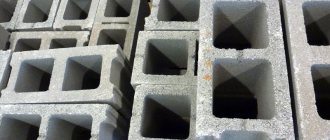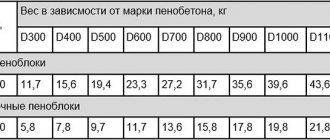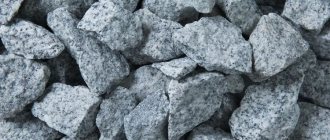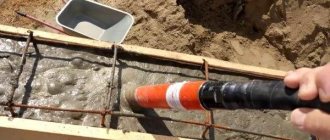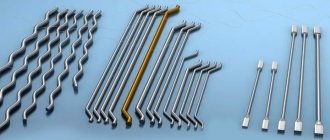The construction market is developing at a rapid pace, offering consumers new, more efficient and practical materials for the construction of residential buildings and industrial structures.
An alternative to the usual brick has long been found, and now this building material is usually used only for cladding. The main structure is created from cheaper and warmer blocks. Twin blocks fall into this category.
In fact, this is a type of cellular concrete with autoclave hardening. The blocks are produced using high-tech equipment, have high technical characteristics and almost ideal geometry.
Description and features
Twin block differs from conventional types of block by the presence of tongue-and-groove locks and very precise geometry. It is made from cellular concrete processed in an autoclave.
The mixture contains several components:
- Portland cement grade 500;
- lime;
- water;
- aluminum suspension;
- fly ash produced by burning coal.
The almost ideal geometry of the blocks and the use of tongue-and-groove locks when laying makes it possible to make masonry joints 2-3 mm thick. This feature allows you to build an almost monolithic wall.
What are twin blocks
Twin block is cellular concrete, autoclaved and high-tech. Made according to the standard, it meets modern requirements for masonry materials. It is durable, lightweight, fire-resistant, vapor-permeable. It has low density and excellent heat and sound insulation properties.
Considering their relatively light weight, it can be quite successfully used for the construction of external walls, while significantly reducing the load on the foundation. The high geometry of the design makes it possible not to level the masonry with mortar, but to use glue when connecting twin blocks.
Production technology
During production, the components are mixed well without moistening, after which water is added to the mixture. As a result, a chemical reaction of calcium hydroxide and aluminum occurs which forms a large amount of gas. The mixture foams, and a porous structure forms in the future block. At the same time, the Portland cement is moistened, and the porous mass sets and hardens.
The hardened mixture is divided into individual building blocks. After cutting, grooves are formed on them for gripping with hands and a connecting groove-ridge.
The quality of product geometry depends on the accuracy of cutting the material. For twin blocks, dimensional deviations of no more than 2-3 mm are permissible. After the products are formed, autoclave processing occurs; the blocks are loaded into a container in which the pressure is raised to 12 MPa and heated to a temperature of 1900 degrees. This processing allows you to achieve precise dimensions and shapes of building blocks.
In addition to accuracy, steaming blocks in an autoclave increases the performance of the blocks and homogeneity. A mass of components react under high pressure, and very strong hydrate compounds appear in the structure.
Pros and cons of the material
Positive characteristics look like this:
- Excellent thermal insulation properties , which were achieved thanks to the porous structure.
- High strength and resistance to dynamic loads. The products are subjected to heat treatment, which increases the density of the material.
- Convenience . The tongue-and-groove system greatly simplifies the laying process. In addition, twin blocks are easy to machine, which makes it possible to build quite complex structures.
- Soundproofing . The size of the product and the porous structure reliably absorb sounds, isolating the interior from street noise.
- Fire resistance . The material does not ignite and does not support combustion; it can be exposed to open fire for a long time without deformation.
- Frost resistance . The unit is designed for 100 freeze/thaw cycles without loss of characteristics declared by the manufacturer.
Positive qualities include ease of storage and transportation.
Of course, it was not without its drawbacks. In particular, twin blocks have the ability to absorb moisture, which makes it necessary to cover the façade with moisture-repellent plaster. In addition, the material has a high price when compared with aerated concrete and expanded clay blocks with similar characteristics.
Characteristics and properties
Twin blocks, like other materials, have pros and cons. For example, a house built in the Krasnodar region will be quite comfortable, but in the conditions of Yakutia it will be necessary to additionally insulate a house made of twin blocks .
This material is good because:
- Twin block is easier to work with than cinder block and weighs significantly less. But the geometric accuracy of the tongue-and-groove connection is important, otherwise it will not be possible to complete the masonry correctly;
- The composition used in the production of blocks is environmentally friendly, it is not for nothing that it has environmental quality certificates;
- Such blocks are soft and easy to cut with a saw and drill; they can be used to make bars of the required shape for laying an unusual twin-block wall .
Minus the high cost - at least 300 rubles per 1 m3
Transportation and storage of twin blocks
Twin blocks are delivered on pallets with reliable fastening. The material has a certain fragility, like all cellular concrete. To avoid mechanical damage during transportation, pallets are secured to flatcars.
When storing on a construction site, the twin blocks must be protected from precipitation. Cover the pallets with thick plastic film. During loading and unloading operations, the precise edges of the twin blocks should be protected. Only soft slings are used; metal cables are not recommended, they can cause destruction of the blocks.
Kinds
Before purchasing, you need to familiarize yourself with the types of material and its performance characteristics and understand the properties of the twin block .
Based on the specific gravity of the blocks, 3 brands of twin blocks are made:
- D-400;
- D-500;
- D-600.
Short description
D-400. Structural strength equal to B2, has a maximum vapor permeability of 0.25 and low resistance to low temperatures (F50). Thermal conductivity is 0.08 W/m0C;
D-500. Structural strength B5, vapor permeability 0.2. Thermal conductivity is 0.115 W/m0C;
D-600. Structural strength B5, vapor permeability 0.18. Thermal conductivity is 0.131 W/m0C.
Twinblock dimensions
| Brand | Dimensions, mm |
| TB-100 | 630x100x250 |
| TB-200 | 630x200x250 |
| TB-300 | 630x300x250 |
| TB-400 | 630x400x250 |
The number indicated in the marking indicates the width of the block. When dry, the minimum weight of the blocks is 8 kg. (TB-100), maximum weight 33 kg (TB-400).
Table of standard block sizes and weights
| Marking | Geometric dimensions, mm | Groove-ridge | Hand grips | Weight of 1 twin block | On a pallet | ||||||
| length | width | height | Quantity, pcs | Number of m² | Volume, m³ | ||||||
| Density D400 (compressive strength class B 2.5) | |||||||||||
| TB 200 4 | 625 | 200 | 250 | — | — | 13,250 | 36 | 5,62 | 1,125 | ||
| TB 200 4p | 625 | 200 | 250 | + | + | 13,250 | 36 | 5,62 | 1,125 | ||
| TB 300 4 | 625 | 300 | 250 | — | — | 19,875 | 24 | 3,75 | 1,125 | ||
| TB 300 4p | 625 | 300 | 250 | + | + | 19,875 | 24 | 3,75 | 1,125 | ||
| TB 400 4 | 625 | 400 | 250 | — | — | 26,500 | 18 | 2,81 | 1,125 | ||
| TB 400 4p | 625 | 400 | 250 | + | + | 26,500 | 18 | 2,81 | 1,125 | ||
| TBk 300 4p | 590 | 300 | 250 | + | — | 23,405 | 24 | 3,54 | 1,06 | ||
| Density D500 (compressive strength class B 2.5 - 3.5) | |||||||||||
| TB 100 5p | 625 | 100 | 250 | + | — | 8,280 | 72 | 11,25 | 1,125 | ||
| TB 150 5 | 625 | 150 | 250 | — | — | 12,420 | 48 | 7,50 | 1,125 | ||
| TB 200 5 | 625 | 200 | 250 | — | — | 16,560 | 36 | 5,62 | 1,125 | ||
| TB 200 5p | 625 | 200 | 250 | + | + | 16,560 | 36 | 5,62 | 1,125 | ||
| TB 240 5p | 625 | 240 | 250 | + | + | 19,870 | 30 | 4,68 | 1,125 | ||
| TB 300 5 | 625 | 300 | 250 | — | — | 24,840 | 24 | 3,75 | 1,125 | ||
| TB 300 5p | 625 | 300 | 250 | + | + | 24,840 | 24 | 3,75 | 1,125 | ||
| TB 400 5 | 625 | 400 | 250 | — | — | 33,125 | 18 | 2,81 | 1,125 | ||
| TB 400 5p | 625 | 400 | 250 | + | + | 33,125 | 18 | 2,81 | 1,125 | ||
| TBk 300 5p | 590 | 300 | 250 | + | — | 23,405 | 24 | 3,54 | 1,06 | ||
| Density D600 (compressive strength class B 3.5 - 5.0) | |||||||||||
| TB 80 6 | 625 | 80 | 250 | — | — | 7,500 | 90 | 14,60 | 1,125 | ||
| TB 100 6p | 625 | 100 | 250 | + | — | 9,940 | 72 | 11,25 | 1,125 | ||
| TB 200 6 | 625 | 200 | 250 | — | — | 19,875 | 36 | 5,62 | 1,125 | ||
| TB 200 6p | 625 | 200 | 250 | + | + | 19,875 | 36 | 5,62 | 1,125 | ||
| TB 240 6p | 625 | 240 | 250 | + | + | 23,850 | 30 | 4,68 | 1,125 | ||
| TB 300 6 | 625 | 300 | 250 | — | — | 29,810 | 24 | 3,75 | 1,125 | ||
| TB 300 6p | 625 | 300 | 250 | + | + | 29,810 | 24 | 3,75 | 1,125 | ||
| TB 400 6p | 625 | 400 | 250 | + | + | 39,750 | 18 | 2,81 | 1,125 | ||
| Tile | |||||||||||
| Tile P 6.0 | 625 | 60 | 250 | 5,000 | 102 | 3,83 | 1,125 | ||||
Manufacturers
Twinblock is a brand of building material made from autoclaved aerated concrete produced by. This company is the largest manufacturer of aerated concrete blocks in Russia. Twin blocks are used in the construction of commercial, industrial, residential multi-storey, country and country houses.
It consists of 2 factories, which are located in the village of Reftinsky and the city of Berezovsky. Production takes place on automated lines assembled from WEHRHAHN equipment (Germany). The peculiarity of these production lines is the accuracy of cutting the prepared material and increased productivity.
All building materials are issued with special certificates confirming compliance with international quality standards.
Scope of application of this type of gas block
Due to its technical characteristics, twin block is considered a universal material with a wide range of applications. It is used in the construction of:
- Private houses ( up to 3 floors high).
- Interior partitions in multi-storey buildings.
- Industrial facilities.
- Garage boxes.
- Baths and saunas.
- Outbuildings.
The material contains no chemically active or toxic elements, so it can be used for the construction of educational and preschool institutions, hospitals.
Masonry technology
When laying, use a special glue for twin blocks ; the quality and strength of the walls directly depends on its choice.
Adhesives are sold in the form of dry mixtures containing:
- Very fine sand:
- Portland cement;
- Special additives.
The characteristics of the glue depend on the additives used; manufacturers often hide which of them are used in production.
There are several types of adhesives:
- Thin-layer. With their help, they lay out a wall with seams 3-5 mm thick, which is enough for twin blocks;
- Thick-layer. Universal compositions, seam thickness reaches 10 mm, this makes it possible to compensate for deviations in the geometry of the blocks;
- For the warm season. These adhesives are used at outdoor temperatures from 0 to +50 degrees;
- For low temperature. Used for laying walls at low temperatures.
When choosing the adhesive that is suitable for your conditions, you need to consider several subtleties:
- It is advisable to use the adhesive mixture supplied by the twin block manufacturer. This will allow you to obtain better quality and strength of the masonry;
- Before purchasing glue, you need to evaluate the geometry of the building material. When using uneven blocks, the consumption of the adhesive composition will increase noticeably, since thin masonry layers will not be able to compensate for the deviations;
- You need to buy a mixture that is suitable for the ambient temperature. The use of summer varieties at low temperatures is unacceptable;
- When choosing an adhesive, consider the expiration date and when the material was manufactured.
Twinbolt laying is a creative and interesting job. The method of connecting blocks and their geometry are similar to assembling structures from large Lego elements.
To build partitions and load-bearing structures from twin blocks, it is permissible to use any type of foundation, the main thing is that it is poured according to the rules.
It is more convenient and profitable to build a house from a twin block on a columnar or monolithic foundation. It does not require significant expenses, hiring heavy construction equipment and can be poured independently.
Masonry sequence
The foundation before the masonry must stand, after which it is covered with roofing felt or similar waterproofing. Laying begins from the corner, the waterproofing is coated with a solution 7-12 mm thick and corner twin blocks are installed. Then they pull the cord and assemble the lower support row. It is convenient to monitor the quality of work and the horizontality of the rows with a laser rangefinder.
The result directly depends on the evenness and horizontality of the first row. Check the shape of the corners using a square or carriage.
When 2 rows are ready, work is suspended for a while so that the first rows set and dry a little. The peculiarity of the work is that the supporting rows are laid on a cement-sand mortar, the subsequent rows of masonry are placed on adhesive mixtures.
For floors above doors and windows, special beams are installed; if there is nowhere to get them, available materials that have the necessary strength will do.
The glue is applied to the surface of the twin block in an equal layer no more than 10 mm thick, then a comb spatula is passed over the applied solution. It is necessary that the adhesive composition evenly covers the top and side surfaces of the block.
Final surface leveling
And the ideal geometry of the building material does not guarantee the complete absence of flaws. Irregularities may form, with differences ranging from 2-5 mm. A grinding machine or electric planer will allow you to level the protrusions of the wall. If you don't have them, you can use a hand plane.
Composition of twin blocks
Despite the precision of the design of twin blocks and the peculiarity of their locking connection with each other, they are made from ordinary building materials.
They include:
- Cement.
- Lime.
- Aluminum powder.
- Water.
Many people call twin blocks an ideal building material, since they are quite large in size but light in weight and are not difficult to make.
When laying twin blocks, you can completely abandon the use of mortar. If you have high-quality glue, you can easily perform the entire range of work related to the construction of the walls of a building.
Another advantage when using glue is that the thermal resistance of the entire masonry increases, which significantly reduces the drying process, which, in principle, is already minimal, and also increases the heat retention properties of the material.
Price and reviews
The material is produced under the brand name Twinblock.
| Name | Dimensions: one twin block cube | Cost of one cube |
| Teplit TB 100 | 625x100x250 | 3260 RUR |
| Teplit TB 200 | 625x200x250 | 3260 RUR |
| Teplit TB 300 | 625x300x250 | 3260 RUR |
| Teplit TB 400 | 625x400x250 | 3260 RUR |
Comparison of twin blocks with other materials
What is better - twin block, foam block, or brisolite - the comparison table will help you figure it out:
| Twinblock | Foam block | Brizolit |
| High design geometry | Not always perfectly level | High design geometry |
| Tongue-and-groove locks minimize “cold bridges” | When laying, glue can be used, but then it is necessary to coat the seams on the outside | Tongue-and-groove locks minimize “cold bridges” |
| High block strength | Quite fragile blocks | High block strength |
| After laying the walls you need to treat them with a water repellent. | Additional wall treatment required | Additional treatment of walls after masonry is required |
| High environmental performance | Normal environmental friendliness | High environmental performance |
| A light weight | Average weight | A light weight |
These three building materials are very close in price, application, thermal conductivity and sound insulation properties. However, twin blocks and brisolite are considered more modern, but it is worth remembering that their use must strictly comply with the technology.
Otherwise, there is a chance that a couple of years after construction you will find a huge crack on the load-bearing wall, which will constantly increase in size. If you don’t rush and don’t save too much, then the finished structure can delight you for quite a long time.


